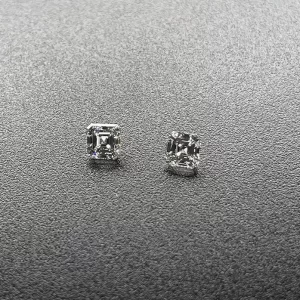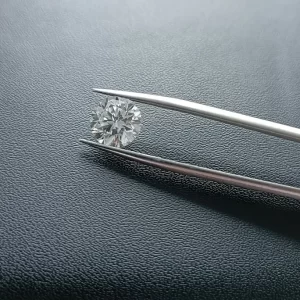Full White DEF VS SI 1ct 2ct Fancy Cut Lab Diamonds Oval Shape
Full White DEF Color VS SI Clarity Oval Shape Fancy Cut Lab Diamonds For Making Lab Grown Diamond Jewelry
Fancy Cut Lab Diamonds Description
Lab diamonds are real diamonds. Carbon is the main element of natural and laboratory-grown diamonds. The chemical and physical properties of synthetic diamonds are same as natural diamonds in terms of hardness, thermal conductivity, and strength. HTHP and CVD are the two main methods for making laboratory-grown diamonds. High temperature and high pressure method (HTHP) uses graphite as raw material. HPHT diamonds are manufactured at a pressure of 5-6 GPA (approximately the pressure produced by a commercial jet landing on a human fingertip) and a temperature of 1300-1600°C. CVD diamonds come from various gases, such as methane. They are stored in a vacuum chamber, which decomposes the molecules of the gas, and then these molecules gather on the pre-existing diamond seeds.
Round cut is the most common cut. Fancy shaped lab diamond, also known as gardener cut diamond, refers to diamonds other than standard round diamonds. The common fancy shape lab diamonds include pear shaped, marquise shaped, princess, radiant, emerald cut, heart, oval shape, etc.
Oval cut diamond is based on the traditional structure of round brilliant cut. Oval diamond has the same beautiful brilliant color as round diamond. Oval diamond because of its length so as to highlight the slender fingers of women, so it is also a very popular diamond shape. The perfect golden ratio for an oval diamond is 1.5:1, which means that the length is about 1.5 times the width. If the aspect ratio is greater than 1.5, a dark area will appear in the middle of the diamond, which is called the bow effect. This kind of diamond is not ideal. If the ratio is less than 1.5, the diamond looks like a deformed round diamond. For cutting, the best depth ratio is 59% – 63%.
The Oval Shape of Fancy Cut Lab Diamonds
If you are looking to purchase a diamond for yourself or a loved one, you may be wondering which diamond shapes are available in the market today. The oval shape is a popular choice among women as it is less deep than other shapes, such as the round and marquise. It has brilliance which is greater than those of the other two shapes. You should keep in mind that the diamond you choose must be in proportion with your budget and taste.
Less deep than a round diamond
As the name implies, fancy cut diamonds are less deep than round diamonds, and the depth of each stone varies. The ideal diamond is less than six-seven-tenths of an inch, and the Blue Nile’s 1.30-carat round cut is 61.8% deeper. On the other hand, diamonds with less than six-seven-tenths of an inch are considered “less than perfect.”
Fancy cut diamonds can be created in many shapes, including ovals. One of the most popular shapes is the round brilliant, which offers more fire and brilliance than any other shape. Other popular shapes include the oval, which is both trendy and makes a diamond appear larger than it is. Cushion and marquise cuts are also economical, as they require less of the original stone. Less deep than a round diamond, ovals are also popular as solitaire diamonds.
The most important aspect of a diamond’s sparkle is its brightness. During an ordinary day, a diamond will reflect white light. However, when it is exposed to a dark environment, the fire reflected by the diamond is much more prominent. The more light a diamond reflects, the more radiant and sparkly it will appear. Therefore, fancy cut diamonds have perfect proportions.
Among the four Cs, the cut is the most important. A well-cut diamond will sparkle and display a good luster. Cut grades have been established for round diamonds enough to be graded officially. For fancy shapes, however, they don’t have this distinction. The GIA grades cut grades according to the shape and carat weight of the diamond. For example, an oval is a more deep diamond than a round diamond, but this is not true for marquise diamonds.
Less deep than a marquise
The marquise shape is not for everyone. While the elongated shape of this shape makes it a popular choice for many, some people do not like its lack of depth and length. The following are three things to consider before buying a marquise diamond. First, remember that a marquise has a poor length-to-width ratio. You might prefer to purchase a round-cut diamond instead, which will give you a higher carat-to-width ratio.
Another difference between a marquise and an oval is the shape. The marquise has a very elongated shape with points on either end. The brilliant style facet arrangement produces a sleek gem that commands attention. In a ring, a marquise cut is a popular choice for a woman who loves cats. A person who enjoys football might be interested in a marquise-cut diamond.
The middle region of a marquise diamond is called the belly. This region is critical as the point of the stone is created by the intersection of two curved sides. The curving portion of a marquise diamond from the belly to the tip is called the wing. The girdle, or junction of the crown and bottom facets, runs along the bottom of the fancy cut gem and is called the keel line.
If a diamond has less than 62% depth, it will have a bow tie affect. Because the bow tie affect has more complex facets, it is more difficult to recognize in real diamonds. Therefore, the diagram shown here is only an example and never accurate. In addition, the bow tie effect is usually invisible. If you are interested in buying a diamond with a bow tie effect, consider buying one with a warmer color.
Less deep than a cushion
If you’re considering buying a diamond, you might wonder how to decide if you want a cushion cut or a round. Both shapes have their benefits. A cushion cut diamond is the most brilliant of all diamond cuts and conceals inclusions better than any other shape. Cushion cut diamonds also tend to be smaller in size. The cut of a cushion diamond is similar to a ciabatta roll, and is named for the rounded corners. Its shape is also square or rectangle with multiple flat faces.
The shape of a cushion diamond is largely dependent on the ratio of length to width. A 1:1 ratio will give you a square-like shape that is closest to the round brilliant cut. Higher ratios will create an elongated diamond with more finger spread. These diamonds are also much less common than square shapes. If you’re looking for a ring with a cushion shape, you may want to look into a custom-made one.
A cushion diamond’s girdle is usually chunky. Inclusions can be easily hidden by a cushion diamond’s shallow depth. A chunkier style is also more likely to contain large, open facets. While a cushion diamond is eye-clean under normal viewing conditions, it may have a few inclusions underneath. These are visible only under a microscope or magnifying glass.
A cushion diamond is the most popular shape of fancy cut diamonds. It was the most popular shape for over 200 years, but had a short-lived period of decline during the 19th century. Then, it underwent a massive comeback in the last century. It was the creation of Marcel Tolkowsky, who refined the cushion cut, laying the foundation for the perfect diamond cut. Before the introduction of fancy cuts, most diamond rough has the crystal form of two pyramids stuck together. Tolkowsky developed a process to minimize the culet and increase the table’s depth, which widened the crown and lowered the table’s height.
More brilliance than a round diamond
Fancy cut diamonds have 58 facets, making them more brilliant than a round diamond. They have long flashes of sparkle and a geometric shape similar to a staircase. The oval and trillion are less brilliant, but they have a contemporary silhouette. Although the terms shape and cut are often used interchangeably, it’s important to understand the differences. In this article, we’ll compare the two terms and explore what each type of cut offers.
More brilliance than a round diamond is an advantage of fancy cut lab diamonds. These diamonds are cut in a way that maximizes light reflection. As a result, they have greater fire and brilliance than round diamonds. A fancy cut diamond may have a higher fire and color level than a round diamond, giving it a more beautiful, distinct character.
The GIA grades round diamonds on a scale from Excellent to Poor. There are several other factors to consider as well. GIA excellent cut diamonds can be beautiful or dull depending on other attributes. However, there are many diamonds that have lower clarity grades than ideal ones. GIA Excellent diamonds are generally the best bet for an engagement ring. However, this is not always true.
Choosing the right shape can be challenging. Fancy cut diamonds can be more expensive than round diamonds. Choose one with a certificate to guarantee quality. While fancy cut diamonds may seem more expensive, they do have higher brilliance and are generally more affordable. The price difference between the two is not significant. In most cases, the round brilliant diamond is a better choice when you want an emerald-cut or a princess cut.
Common problems with oval cut diamonds
When shopping for an oval diamond, you’ll notice a few common issues. This diamond is prone to dark tips, making its color appear more noticeable. To avoid this, consider paying more for a diamond with a higher color grade. Alternatively, you can perform an ASET (r) test to determine its bow tie. In either case, make sure that the diamond is cut to perfection and that it has a high carat weight.
Compared to round diamonds, ovals require less precious rough material for the cut. They are less expensive than round diamonds and require less depth. The shape also makes the stone appear larger, making it an excellent value for the money. But you should be careful – oval diamonds have a tendency to look “bow tie”-shaped, so they might not be the best choice for a ring.
In addition to poor symmetry, oval diamonds may not be cut well. Poor cut can result in an elliptical shape, giving them an uneven look. Another problem is that diamonds with poor symmetry are harder to spot in grading reports. The GIA certificate may say Excellent for symmetry and polish, but these cuts are often not. A poor cut can make the stone appear dull, brittle, or even distorted.
Another common problem with oval cut fancy cut lab diamonds is the bowtie effect. Bowties occur in diamonds due to problems with light distribution. Usually, light doesn’t penetrate the middle of an oval diamond. In these cases, the bowtie affect can distract from the beauty of the stone. If you want a diamond with the bowtie effect, avoid oval diamonds with a prominent bowtie.
Full White DEF VS SI 1ct 2ct Fancy Cut Lab Diamonds Oval Shape

















